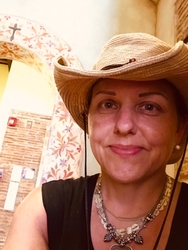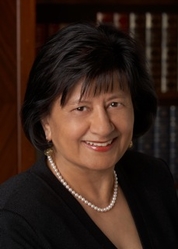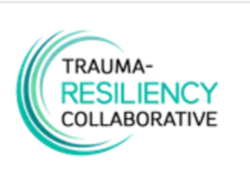It all started with a conversation on a bus.
The idea of the Health Resiliency Stress Questionnaire (HRSQ) was born out of banter between a pediatrician visiting Salt Lake City from the San Francisco Bay Area and me. We happened onto that topic directly after the first Utah-based symposium on Health, Resiliency and Trauma in October 2014. This symposium was sponsored on a shoestring budget by the fledgling group, the Trauma-Resiliency Collaborative.
It was important to me that the symposium was free to all participants

because I knew that we, professionals from our community, needed to do a whole lot better with spreading the “good news” that recovery from trauma is possible. My new-found colleague, Dr. Tasneem Ismailji, was one of the guest speakers at the conference. She happened to be in town for a board meeting for the Academy on Violence and Abuse, the consulting organization for the symposium. We had a lot in common, including the objective to spread the good news to the primary care community.
Later that night, I found myself nearly obsessed with creating a tool for primary care providers that could capture both adverse childhood experiences (ACEs) and the mitigating effect of resiliency characteristics. That conversation on the bus with Dr. Ismailji prodded me to craft an initial design. I wanted it to be clear, concise, quick, and very easy for providers to “glance and go”, meaning, easy for patients to complete and easy for providers to see a pattern and respond accordingly with a brief response that could change everything.
Grandiose? Not really. Just driven to help reshape the way patients/clients are “seen” by their providers. I had already gotten to a point of deep frustration with the lack of trauma-awareness, let alone trauma-informed, anything. Even

through my medical, residency, and fellowship training, even through the addiction-treatment center and high-level psychiatric programs for which I had worked, nearly no one acknowledged the importance of trauma as the epicenter for serious health, psychiatric, and psychosocial problems. I had been screaming and no one was listening.
Starting the TRC was the first step, the symposium was the next, and the HRSQ was then the next logical move. And, it started on a bus, from a conversation between strangers.
The Trauma-Resiliency Collaborative (TRC)
Shortly after the first symposium, we regrouped. The founding members of the TRC stuck with me in this venture forward to spread the word and educate our community. I was determined to create a culture for us to speak the same language about the power of resiliency that mitigates the effects of ACEs. As a psychiatrist, I know that the power of language can change everything, especially language that acknowledges the existence and experiences of others. This became the mission of the TRC. This think-tank group of multi-disciplinary professionals, paraprofessionals, and peer advocates, together we broke down silos and created a culture for conversing, sharing and supporting each other’s ideas, objective, projects, symposium, and more. The TRC was a natural bevy for vetting the HRSQ, among other outstanding endeavors.
psychiatrist, I know that the power of language can change everything, especially language that acknowledges the existence and experiences of others. This became the mission of the TRC. This think-tank group of multi-disciplinary professionals, paraprofessionals, and peer advocates, together we broke down silos and created a culture for conversing, sharing and supporting each other’s ideas, objective, projects, symposium, and more. The TRC was a natural bevy for vetting the HRSQ, among other outstanding endeavors.
The fruits of pro bono dedication for the HRSQ project from this group propelled:
- the honing of questions: insights for the “how to’s” for primary care providers to communicate differently with their patients in pediatrics, family practice, and internal medicine
- hands-on feedback from therapists about the deepened perspectives about their clients
- time-intensive patient/client data collection from numerous sites
- doctorate candidate studies about the ease, utility, and salient impact of the instrument in medical settings
- very promising results from the statistical rotation analysis
The motto for our bimonthly 90-minute dinner-meetings has rung true for the development of the HRSQ (and every collaborative project tethered to the TRC): “Check your ego at the door and bring in all of your expertise”, as we are on a mission!
Practical Use
The HRSQ is designed to make the process of asking some tough questions easy. It is also designed as a vehicle for the patient/client to be “seen”. We know this from the data that Dr. Vincent Felitti collected: By simply asking the question(s), there is a predictable 30-35% reduction in unnecessary primary care visits. Why would that be? Well, when we feel that we have been “seen”, that translates to feeling validated. The word feeling is the most important word here.
Feelings allow us to gain a bit more perspective on what we experience. Feeling is often taboo in our culture — and especially in the medical field. Feeling is quite often misunderstood to be a process of “emotional breakdown”. Yet, it is only through understanding (and validating) our feelings that we are paradoxically made strong from within. When feelings are validated through simple statements and gestures, the feeling can then be released appropriately instead of being buried or dismissed. It turns out that allowing feelings to surface, then acknowledging those feelings, then responding appropriately to feelings by choosing effective behaviors, we end up affecting our neurobiology in a positive direction, which affects our health positively. And, when we are feeling healthy and whole, our mind and subsequently our choices are also healthy and whole. We begin to trust ourselves and our ability to improve our health. That is how powerful feelings are and why those need to be acknowledged and honored.
The opposite is true for withholding, dismissing, and burying feelings. This pattern creates what I call the hiding that harms. With such “unfinished business”, we predictably hide from ourselves and hide from others. This only causes more compounding toxic, emotional stress. This leads to reactive and destructive behaviors and is associated with the many deleterious outcomes associated with ACEs and other toxic stresses (e.g., pro-inflammatory states that give rise to chronic health conditions, addiction, suicidal ideation, etc.). When we are living in the hiding that harms, we are avoiding the exact thing that allows us to positively improve health: regulating, not controlling and shoving down our feelings.
Emotional health is tied to our physical health and resiliency. It is fundamental to our ability to heal. For this important reason, I was ignited by the challenge that my colleague posed to me during that conversation on the bus. From my years of developing clinical expertise in treatment for recovery from trauma and addiction, I knew that resiliency can be learned and has a powerful and mitigating effect on the impact of trauma. But, if the question is never asked, the healing can never begin. For this reason, the HRSQ was begging to be written and has been supported by multi-disciplinary professionals.
Creating the HRSQ started with that conversation on the bus, creativity and clinical expertise. However, it was a truly collaborative effort among multi-disciplinary professionals to produce this easy-to-use and clinically relevant questionnaire. After the first few drafts and test piloting in my practice, I brought it to the collective of the TRC to weigh in their opinions. It was then that Dr. Mary Beth Vogel-Ferguson, research associate professor in the University of Utah College Of Social Work, showed up to her first TRC meeting. She was instrumental in honing the HRSQ and recommended the addition of validated screening components to assist with internal validation and strengthen the instrument. After a few more drafts, we had a first tool for a pilot study. Then, it was a matter of convincing non-mental health providers to use the tool.
A courageous, well-respected, and nearly-ready-to-retire pediatrician, Dr. Bill Cosgrove, was the first to volunteer. He said: “I will do it, but I don’t know how to start the conversation.” It was then that we added the suggested introduction. Soon enough, Dr. Cosgrove found his own interpretation of that introduction and groove with administering and reviewing the HRSQ with parents. He knew that if he could change the parents’ trajectory toward health, then the newborn’s life trajectory will also improve. He was sold on the value of the HRSQ. And soon, an internist, Dr. Mara Rabin, implemented it in her internal medicine practice; she recognized the importance and value of the HRSQ, based on her extensive work with a volunteer organization for refugees.
The data collection for the pilot study was additionally collected from a therapy group practice skilled in trauma-resolution work, Healing Pathways; an addiction treatment center, Ascend Recovery; two doctorate of nursing candidates, and my private practice. Having data was great, but not having an expert who understood the value of the tool was another matter. That is when Philip Jonathan Osteen, associate professor in the University of Utah College of Social Work, showed up — or was perhaps delivered from above! His expertise in psychometrics was the key piece that the HRSQ was needing to determine if the numbers were congruent with the clinical value that all were enjoying. Indeed, the rotation analysis demonstrated what we were seeing.
The Exploratory Factor Analysis (n=276) assessed that the data-driven factor structure aligns with the proposed instrument factor, meaning very favorable results! Since then, we have made a few changes in the wording of a few questions and have developed the e-HRSQ. The extensive programming was donated, to ensure HIPAA compliance. Why? Because the programmer also understood the importance and value of this instrument. As a final blessing, Dr. Felitti articulated his enthusiasm, too, at a Chadwick presentation on the findings of the HRSQ in January 2019.
Since the beginning of this journey, Dr. Dave Corwin — professor of pediatrics at the University of Utah School of Medicine, founding member of the TRC, AVA and several other national organizations — has been instrumental in educating individuals and agencies about the HRSQ.
In introducing the HRSQ to medical professionals, we noticed that some of those professionals were fearful to start using the HRSQ. Once I included the “ice breaker” language to start the conversation, every single provider was hooked. They quickly realized that a 2- to 5-minute conversation with their patient/client opened up insights to health risks. They also realized that for many, very helpful interventions could be as simple as suggesting a website, book, or guided meditation. For others, referrals for a clinic follow-up appointment, therapy, or other expertise was clinically important.
Currently, the HRSQ is being used in two primary care clinics, and soon it will be launched in all University of Utah community clinics.
The HRSQ provides a window for providers to empower their patients/clients toward healing. And, emotional healing has reems of scientific studies that demonstrate the profound positive effects on not only neurobiology, but also endocrinology (hormone system) and the immune system. These systems are orchestrated through the limbic system, the emotional engine, plus the hypothalamic-pituitary-adrenal axis (aka the regulation pathway ) with the purpose for keeping the body in balance (i.e. homeostasis).
Continued Propagation and Improvement
The HRSQ has all resulted from the goodness of the hearts of many, meaning: no funding and a lot of dedication and time. We are now ready to launch this to the world, while we continue to study the capacity of the instrument.
The HRSQ will remain free to the world. And, we are dedicated to advancing the utility of this instrument so that providers will continue to empower the health of patients/clients. My envisioned long-term goals for the HRSQ include:
- to produce a risk-value score that will be able to suggest reliable treatment, monitoring, and self-help/empowering strategies for primary care providers, therapists, and other providers to recommend to patients/clients ;
- to demonstrate positive treatment effect across time.
We will need large data sets and community-wide participation to attain these goals. And everyone is invited to do a small part, which will help make this happen! Accomplishing these aims will make my challenge from Dr. Ismailji complete.
We invite you to use the HRSQ in your practice and clinical settings as a vehicle to help empower your patients/clients and positively affect their health. When you do use the HRSQ, we invite you to add to the database to further our study of this tool.
Health Resiliency Stress Questionnaire (HRSQ)
The HRSQ provides a quick overview of a person’s ability to tolerate and cope with stress in relationship to their health. It was designed for busy health clinics, and it is also valued by therapists, treatment centers, and individuals. It identifies and quantifies resiliency skills (strengths), tolerance to stress, expanded Adverse Childhood Experiences (ACEs) and other experiences of trauma and/or violence that cause toxic stress.
The HRSQ is an efficient, self-administered tool that can be completed in about 4-5 minutes in a waiting room, exam room, or at home. It can be used to identify areas of strength and risk of resiliency that can change over time in response to healing from the effects of ACEs and other toxic experiences.
There are two easy ways to participate:
1. Paper version (pdf)
HRSQ w/o Instructions (pdf) and HRSQ WITH Instructions (pdf)
Instructions:
Can be completed in the waiting room or at home. Fax the completed paper copies (de-identified) from the provider's office to 844-838-8100. The HRSQ is HIPPA compliant.
2. Electronic version — e-HRSQ
Instructions:
- Provider or designated staff will register once on the Provider Registration-HRSQ website. Establishing an account takes about 30 seconds.
- Clinic/provider will provide each patient/client with a simple code that is internal to the clinic (e.g., Clt#1 or Dr.S’s#2, etc.).
- Provider receives results by email (the de-identified result will list the clinic-generated code, so that the correct patient chart can be matched).
The e-HRSQ is HIPPA compliant, as all information is de-identified. In addition, the IP address is electronically scrubbed/deleted from the database. Only the numerical answer-scores, race, gender, and zip code are recorded, and none are required (all optional). The data entered will be use for research to study the utility of this instrument. (The future goal is to assist providers with treatment recommendations by sorting out who may need different types of treatment recommendations from their provider.)
Feel free to use our simplified patient/client informed consent (simplified) to introduce your client/patient to the HRSQ.
The TRC will provide recognition and thanks for provider/clinic participation during lectures on the HRSQ. Healing, health and wellness takes a community!
I am so excited to put this out to the world, because we are already seeing such positive impact in expected and unexpected ways for both patients/clients and providers. The main goal for the HRSQ is to help people heal by seeing themselves and others seeing them: creating healthy connection, the foundation for resiliency!






Comments (9)